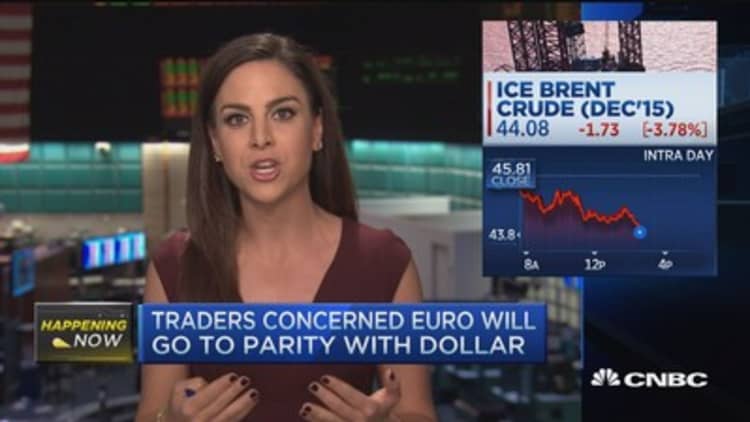



Markets could stress over the price of oil Friday, as investors also watch October's retail sales for any new signals about the health of the consumer.
A continuing slide in oil prices took a bite out of stocks Thursday, and energy traders are watching to see if U.S. crude futures retest August lows of $37.75. West Texas Intermediate oil futures fell 2.8 percent Thursday to $41.75 per barrel, the worst performance since late August. WTI is now down 11 percent since the start of the month.
Falling oil made a nervous stock market even more anxious Thursday, and the Dow fell 1.4 percent, its worst loss since Sept. 28. The fell 1.4 percent to 2,045.
"Psychologically, $45 was the important level," said Art Hogan, chief market strategist at Wunderlich Securities. "Once we got below that, the correlation between WTI and the S&P tightened up significantly. What we need to see is what's the next level. ... We need to stay in the $40s."
Read MoreOil price collapsing, could set new low
The monthly retail sales data come on the heels of a string of warnings this week from big retailers, like Macy's and Nordstrom, so traders are watching the report carefully to see whether it signals a weakening consumer. Economists are expecting headline sales to rise 0.3 percent, compared to 0.1 percent in September. Excluding autos, the sales are projected to rise 0.4 percent.
"It doesn't connect with what we're hearing from the retailers. (Retail sales data) gathers a whole lot more than that," said Hogan. He said the sell-off in retailers may be overdone since warm winter weather could really be just a temporary factor behind their soggy sales outlooks.
Read MoreWhy stocks are ready for a pullback
"We're pricing in some pretty bad news on the consumer front that may be an overreaction," Hogan said, adding that consumer behavior may be changing and that too could be affecting traditional retailers.
Tom Simons, money market economist at Jefferies, points out that strong auto sales are a sign that consumers are pulling their weight. He said eating and drinking establishments will likely show up strong in the monthly sales data, even if consumers are not shopping as much for things like clothing.
"I'm not worried about the consumer. I'm not worried about the overall economy," he said. "GDP is two-thirds consumption. If that falls off, we're in deep trouble, but I don't think it's going to. There's been some sketchy periods over the last couple of years but consumption has still been good."
Simons said one point of concern, however, is the falling price of oil which he watches along with other commodities, as a preferred inflation gauge over PPI. He said if it drops too much the market may start to question the potential for a Fed rate hike in December.
While stocks reacted to oil Thursday, traders also watched speeches from six different Fed officials. The most important speech during trading was New York Fed President William Dudley. Simons said he was surprised that Dudley did not sound more definitive about a December rate increase. Dudley said it's possible that Fed officials could soon find the conditions necessary for a hike.
Read MoreTrader predicts 'upside surprise' for this hot sector
"He was a little more cautious than I thought he would be," said Simons, adding the market did not appear to react.
Deutsche Bank's chief U.S. economist, Joseph LaVorgna, was also watching oil relative to the possible Fed rate hike, coming on Dec. 16. "The lower commodity prices go, the more likely goods prices, ex-energy, are going lower. That's deflationary," said LaVorgna. "The fact we're making new lows when you have mixed factory data here and abroad tells you maybe demand isn't there. And here you are in the seventh year of the business cycle, and the Fed's raising rates."
LaVorgna said market expectations for a rate hike could waiver if retail sales or another number is weak, and he expects the market's pricing of odds of a rate rise to fall to about 50 percent by the time of the Fed meeting. The market was pricing 70 percent odds of a December hike, after the October jobs report showed stronger-than-expected payrolls and wage acceleration.
Read MoreBarclays: Buy the coming market sell-offs
There is also inflation data Friday, with the producer price index for October expected to rise 0.1 percent, when released at 8:30 a.m. ET. Consumer sentiment and business inventories are both reported at 10 a.m.
Oil, however, will have many traders attention.
Crude's fall accelerated when the dollar began rising after last week's strong jobs report raised expectations the Fed could hike in December. "The market got very comfortable with oil between $44 and $49, and then on the hot jobs number when the dollar got strong, it started to leak," said Scott Redler of T3Live.com. "Now it's in jeopardy of retesting the lows. There wasn't much volatility when oil was between $44 and $49. But below $44 raises eyebrows, and below $40 volatility spikes once again."
The rising dollar has been a negative for oil, but so was new data that showed U.S. stockpiles rising at the same time as Chinese industrial demand looks softer.
"That's a perfect storm of bad news for any commodity, and oil is the most important one," said Hogan.
Redler, who follows short-term technicals, said traders are looking for a gap down in the S&P 500 on the open Friday, so they can buy the dip. But if that doesn't happen, the S&P could struggle in a key technical zone and it will have to hold 2,020, he said.
Besides the data, retailer J.C. Penney also reports earnings before the bell, as do Tyco and Berry Plastics.


